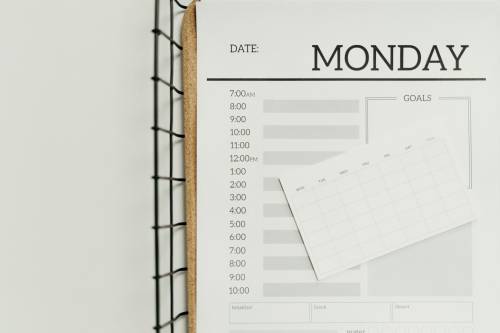

Whether you realize it or not, time is our most valuable asset. That’s why most successful people manage their time to maximize results. You have heard of time blocking before, but this is another plug for this method if you are ready to try this plan or get inspired to get going again.
In time blocking, specific tasks are broken up into specific blocks of time. Many successful people, including Steve Jobs, Benjamin Franklin, Elon Musk, Jack Dorsey, Marc Andreessen, and Cal Newport use time blockers to manage their time effectively.
Basically, those individuals are squeezing every drop out of their day with time blocking. Furthermore, it is simple and effective. And — here’s how it’s done.
What is Blocking?
Though Benjamin Franklin may not have been the first to use time-blocking, he was an early adopter. He meticulously detailed his daily activities, including chores and rest. For deep work, he blocked off hours at a time and offered himself two hours for lunch.
In short, time blocking has become a strategy for managing your time by scheduling out all aspects of your day. This allows you to divide the work week into bite-sized scheduling events during which you may check your email, work on projects, exercise, or even take a break.
By using time blocking, you can reclaim your day and better understand how your time is spent. According to the Anatomy of Work Index, approximately 71% of knowledge workers reported feeling burnout in 2020. In addition, 32% of the people cited the inability to switch off or disconnect as the main cause of their burnout.
By scheduling blocks of time, you can ensure that your important tasks are completed on time. Additionally, you will be able to schedule time for self-care and rest.
Time Blocking Variations
Using time blocking to streamline your workday can be done in a variety of ways:
Traditional time blocking.
You can make your day more efficient by dividing it into specific time blocks, each dedicated to a specific activity or task. To-do list items are assigned fixed scheduling events in your calendar based on your schedule in advance.
Task batching.
The concept of task batching is to group similar, usually smaller, tasks together and schedule specific time blocks to complete them all simultaneously. The more often you can tackle similar tasks in a group, the less time and mental energy you have to spend switching contexts throughout the day.
For example, when processing email throughout the day, schedule two 20-minute blocks rather than checking your inbox frequently.
The benefit of time blocking is that it saves you from having to schedule each task individually on your calendar. Set aside chunks of time every day or week for certain activities, such as emailing, invoicing, exercising, meeting, writing, coding, deep work, running errands, and preparing meals.
Day theming.
Another way to block time is through day theming, which may be effective for those with many responsibilities. Thematic days allow you to dedicate a full day to one particular set of tasks, rather than setting aside time blocks for each area of responsibility.
In this case, task batching is taken to an extreme. For each day, you compile all the tasks that are related to an area of business. An organization’s leaders may choose a day to focus on finance, another day on marketing, and yet another day to tackle strategy and operational tasks.
Timeboxing.
Often, time blocking and time boxing are confused as synonymous, but they differ in important ways. Blocking your time allows you to focus on a specific task or activity for a specific period of time. As an example, “I will work on my blog post from 9 am to 11 am tomorrow morning.”
A time box, on the other hand, limits the amount of time you dedicate to a task. Continuing with the time-blocking example above, let’s have a look at a time-boxed version: “I’ll finish my first draft of my blog post between 9 am and 11 am tomorrow morning.”
Due to the limited amount of time you have to accomplish the task, this self-imposed “time box” forces you to work efficiently. By gamifying your productivity, you can challenge yourself to meet your goals.
Additonal time types of time blocking.
- Energy management time blocking. Adapt your day to your energy level. You might schedule your most demanding tasks in the morning and then work on less demanding tasks in the afternoon if you’re an early bird.
- Pomodoro technique. Working in short, focused intervals followed by a brief break is a modification of traditional time blocking. A longer break follows the completion of a set number of intervals (usually four).
Why is Time Blocking So Effective?
Despite its simplicity, this technique can have a profound impact on your productivity:
It encourages focused “deep work.”
Time blocking is highly recommended by Cal Newport, the author of Deep Work: Rules for Focused Success in a Distracted World. Every evening, he spends 20 minutes planning out the next day’s tasks:
“Sometimes people ask why I bother with such a detailed level of planning. My answer is simple: it generates a massive amount of productivity. A 40-hour time-blocked work week, I estimate, produces the same amount of output as a 60+ hour work week pursued without structure.”
It is more efficient to devote all of your mental resources to one task than to spread your attention thin over several tasks at once. It becomes easier to stay focused the more you “single task” and build the mental muscles for deep work.
By blocking time, deadlines are created.
Whenever we let tasks fill our time, they tend to do so. Known as Parkinson’s Law, this is a significant principle when it comes to time management.
Suppose I gave myself four hours to write an article. That’s how long it would take me. But would it be any better if I gave myself two hours? What would be the added value of finishing this article as well as three more?
I don’t think so.
Limiting the time we spend on a task makes us more productive. In the end, we get more done, and the results are just as good or even superior.
You’ll be more aware of how you spend your time.
Time management is a problem for most people. We tend to underestimate how long tasks will take and to overcommit ourselves in the future. You are forced to think more critically about your commitments and priorities by blocking time.
As you add commitments to your life, you must find physical space on your calendar for them. Also, because of this, saying “yes” presents a much more concrete opportunity cost, and saying “no” becomes much easier.
Keeps you from procrastinating and striving for perfection.
The hardest part of doing anything is getting started. It isn’t easy to know where to begin. It’s even worse if you have a huge to-do list.
By creating a blocked schedule, you can stop procrastinating.
This way, you won’t have to worry about which step to take first. Except for the time on the clock and the task on the schedule, it takes everything out of the equation.
You also don’t have the time to worry about getting everything precisely right since you have deadlines and time limits. In turn, this keeps perfectionism at bay.
Accountability is created by block scheduling
When you start block scheduling, you become more aware of your time management. You will gain the most if you confront this, but it can be challenging.
It is your responsibility to fill in the blocks. It’s no longer acceptable to make excuses like “I just don’t have time to exercise and eat healthy.”
As a result, you can control your time and everything you do.
Here are some of the advantages of time blocking:
- Improved focus and productivity. It is less likely for you to be distracted when you know what you will work on and when you will work on it. The result can be an increase in productivity.
- Better prioritization of tasks. Making sure you work on the most important things first is easier when you block out time. By doing this, you can avoid procrastination and accomplish more.
- Promotes a flow state. When you’re in a flow state, you’re focused and more efficient. By blocking out specific parts of your day (and nothing else), you can achieve a flow state.
- Reduced stress and increased sense of control. The more planned your day is, the less likely you are to feel overwhelmed and stressed. By doing this, you can gain greater control over your life and time.
- Better work-life balance. It is essential to schedule time for work, commitments, and self-care. By time blocking, you can achieve a more balanced schedule.
- Less context switching. The concept of context switching refers to the transition from one task to another. As a result, productivity can be decreased as a result of this disruption. By scheduling time blocks for specific tasks, you can avoid context switching.
Although time blocking isn’t a magic bullet, it can be a very effective way to increase productivity and time management. You might want to consider time blocking if you’re looking for a way to get more done.
Tips to Start Time Blocking Your Schedule Today
Even though time blocking seems simple in theory, implementing it consistently can be challenging. These tips will help you manage your calendar effectively and get the most out of your schedule.
Identify your priorities.
Is there anything you need to accomplish that is of the utmost importance? You can start blocking out time for your priorities once you know what they are.
Estimate how long each task will take.
Identify how long you expect each task to take and be realistic about it. As a result, you won’t overbook yourself. More importantly, this will prevent you from over-or-underbooking your time blocks.
Schedule your time blocks.
When you know how long each task will take, you can schedule time blocks for it. Keep your schedule flexible in case something unexpected happens.
Set deadlines for yourself.
By setting deadlines, you can stay on track and avoid procrastination.
Set aside time for non-work activities.
Throughout the day, it’s important to relax and take breaks. Organize time for activities you enjoy, such as exercise, reading, or spending time with family and friends. You should also consider personal responsibilities like household chores and running errands.
Be flexible.
Don’t be surprised if your time blocks must be adjusted, since things don’t always go according to plan. To address this, you may want to add leave-free blocks in your calendar throughout the day. For example, you could leave from 1:00 pm to 1:30 pm blank each day in case there’s an emergency.
Use a time-tracking tool.
If you do this, you’ll be able to see how you’re spending your time and identify areas for improvement.
Take breaks.
It’s crucial to take breaks throughout the day to prevent burnout. Make sure you move around or get some fresh air outside by stepping outside.
Here are some additional tips that you may find helpful:
- Make use of a time-blocking tool. Google Calendar, Asana, and Trello are some of the time-blocking tools available. These tools can make visualizing your schedule and tracking your progress easier.
- Organize similar tasks together. By doing this, you will keep your focus and avoid switching tasks too frequently.
- Avoid multitasking. You can actually be less productive if you multitask.
- Delegate tasks whenever possible. Your focus can then be on what’s really important instead of wasting time on the little things.
- Take care of yourself. Exercise regularly, eat healthy foods, and get enough sleep. The more energy you have, the more productive you will be.
It takes time and practice to get time blocking right, but it can be very effective. Try out different systems until you find one that works for you, and be patient with yourself.
Here are some examples of how you can use time blocking:
- You can set aside time for specific tasks, such as writing, researching, and responding to emails each day.
- If you need to work on a presentation or write a report, you can set aside a certain amount of time for the project.
- It might be helpful to schedule time for specific types of tasks, such as creative or administrative work.
- Time could be blocked off for personal tasks like exercise or meditation.
Your individual needs and preferences will determine how you use block off time. Find what works for you by experimenting with different approaches.
FAQs
What is time blocking?
As part of time blocking, you schedule specific blocks of time for different tasks. As a result, you are able to focus on one task at a time and avoid distractions.
How does time-blocking work?
The first step in time blocking is determining the most important tasks for the day or week. After that, you must figure out how long each task will take. You can schedule chunks of time on your calendar after you know how much time is needed for each task.
What are the benefits of time blocking?
You can benefit from time blocking in the following ways:
- Avoid distractions and stay focused
- You can accomplish more in less time
- Organize your tasks by priority
- Keep interruptions to a minimum
- Reduce your stress levels
- Enhance your productivity as a whole
Are there any drawbacks to time blocking?
When you’re not used to time blocking, setting it up can be time-consuming, and following it can be difficult. Although time blocking has its drawbacks, its benefits often outweigh them.
What are some common mistakes to avoid with time blocking?
With time blocking, you should avoid the following mistakes:
- Overbooking yourself. Try not to cram too much into your day. Make sure you leave time for unexpected events and breaks.
- Not being flexible. Don’t be surprised if your schedule changes at the last minute, as things don’t always go as planned.
- Not sticking to your schedule. Keep your schedule as much as possible, even if it’s easy to get sidetracked.
Featured Image Credit: Cottonbros; Pexels; Thank you!











John Rampton
John’s goal in life is to make people’s lives much more productive. Upping productivity allows us to spend more time doing the things we enjoy most. John was recently recognized by Entrepreneur Magazine as being one of the top marketers in the World. John is co-founder and CEO of Calendar.